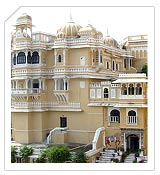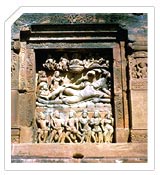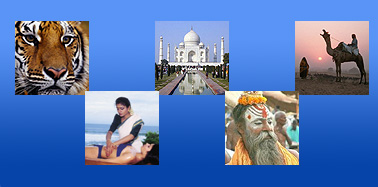|
 Deogarh in Rajasthan is situated on the boundaries of Mewar, Marwar and Merwara, about 80 miles north-east of Udaipur. At a height of about 2100 ft above sea level, it is cooler than other parts of Rajasthan. The chief of Deogarh, known as 'The Rawat' was one of sixteen umraos (feudal barons) entitled to wait upon the Maharana of Udaipur, the capital of Mewar. These type of feudal estates, called 'Thikanas' were sanctioned by the ruling Maharana to a nobleman either due to blood relationship or for an act of valour. Deogarh is also famous as a school of miniature painting. Some Deogarh miniatures embellish the personal collection of the present Rawat Sahib. Frescoes of this art form can also be seen on the fort walls. The palace also has some interesting rooms to venture through - Sheesh Mahal - the colourful hall of mirrors, is one of them. Deogarh in Rajasthan is situated on the boundaries of Mewar, Marwar and Merwara, about 80 miles north-east of Udaipur. At a height of about 2100 ft above sea level, it is cooler than other parts of Rajasthan. The chief of Deogarh, known as 'The Rawat' was one of sixteen umraos (feudal barons) entitled to wait upon the Maharana of Udaipur, the capital of Mewar. These type of feudal estates, called 'Thikanas' were sanctioned by the ruling Maharana to a nobleman either due to blood relationship or for an act of valour. Deogarh is also famous as a school of miniature painting. Some Deogarh miniatures embellish the personal collection of the present Rawat Sahib. Frescoes of this art form can also be seen on the fort walls. The palace also has some interesting rooms to venture through - Sheesh Mahal - the colourful hall of mirrors, is one of them.
Best Season to Visit : From October to early April
Sightseeing at Deogarh -
Deogarh Mahal : This 17 the century Palace is a commanding structure, standing atop a hill offering a panoramic view of the Aravalli mountain range and the numerous lakes, spread through out the countryside. With its greying battlements, domes, turrets, jharokhas and huge gateways, it is a picturesque sight from the town below.
 Deogarh Mahal : has been converted into a hotel about 3 years ago, by the present owner Rawal-Nahar Singh. A part of the Mahal is still occupied by his kin. The family is closely associated with the hotel and personally supervises and monitors the on goings. The care reflected in the minutest details, have made Deogarh a benchmark of Heritage Hospitality in Rajasthan. Deogarh Mahal : has been converted into a hotel about 3 years ago, by the present owner Rawal-Nahar Singh. A part of the Mahal is still occupied by his kin. The family is closely associated with the hotel and personally supervises and monitors the on goings. The care reflected in the minutest details, have made Deogarh a benchmark of Heritage Hospitality in Rajasthan.
Dashavatar Temple : The exquisite Vishnu temple at Deogarh belonging to the Gupta period, popularly known asthe Dashavatar Temple is the earliest known Panchayatan temple of north India. The terraced basement above the high temple plinth is decorated with an uninterrupted row of sculptured panels. Elaborately carved doorway with Ganga -Yamuna images lead to the sanctum sanctorum. Three bigrathika panels set in the side walls have Vaishnava mythological images carved in high relief - the Gajendramoksha panel, Nara-Narayan tapasya and the Anantshayi Vishnu. The Dashavatar Temple at Deogarh is marked for being the first northern Indian temple with a shikhara or spire. Only the lower part of the shikhara remains today.
Manastambha : The group of 31 Jaintemples, though of a later date, are no less notable. The site was a Jain centre from the post-Gupta times upto the 17th century. Panels reflecting scenes from Jain mythology, Tirthankara images, a Manastambha (votive pillar), Ayagpatta (votive tablet), Sarvato bhadra pratima (Jaina images visible from all sides) and Sahastrakuta (pillar carved with a thousand Jain figures) are found here.
Chanderi : Chanderi is famous for its gossamer Chanderi saris. It also boasts of some of the finest examples of Bundela Rajput and Malwa Sultanate architecture. A beautiful Mughal fort commands the skyline of this amazing old town. Among the sights here are the Koshak Mahal, an old palace said to have been commissioned by Mahmud Khilji in 1445, the Badal Mahal Gate -a victory arch, the imposing Jama Masjid, the Shahzadi ka Rouza, a building with decorative arches and the Parmeshwar Tal. Chanderi also has a number of ancient Jain temples, worth visiting.
|


